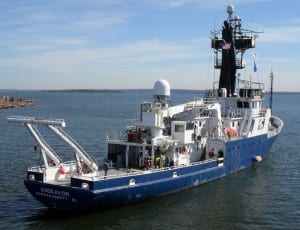
The Research Vessel Endeavor is the floating laboratory that scientists will use for the ocean-going portion of the SABOR field campaign this summer: Tom Glennon/University of Rhode Island
NASA embarked this week on a coordinated ship and aircraft observation campaign off the Atlantic coast of the United States in an effort to advance space-based capabilities for monitoring microscopic plants that form the base of the marine food chain. Phytoplankton, tiny ocean plants that absorb carbon dioxide and deliver oxygen to Earth’s atmosphere, play a major role in the global cycling of atmospheric carbon between the ocean and the upper atmosphere.
NASA has long used satellites to make observations of the concentration of phytoplankton worldwide, but new types of tools are needed if scientists are to understand how and why different species and concentrations of phytoplankton change from year to year, according to a press release.
For three weeks, NASA’s Ship-Aircraft Bio-Optical Research (SABOR) experiment will bring together marine and atmospheric scientists to tackle the optical issues associated with satellite observations of phytoplankton.
On Friday, July 18, researchers aboard the National Science Foundation’s Research Vessel Endeavor, operated by the University of Rhode Island, departed from Narragansett, Rhode Island, to study ocean ecosystems from the Gulf of Maine to the Bahamas.
NASA’s UC-12 airborne laboratory, based at NASA’s Langley Research Center in Hampton, Virginia, will make coordinated science flights beginning Sunday, July 20.
“By improving our in-water and aircraft-based measurements of particles and material in the ocean, including phytoplankton, SABOR will advance understanding of marine ecology and the carbon cycle,” said Paula Bontempi, ocean biology and biogeochemistry program manager at NASA Headquarters in Washington.
One obstacle in observing marine ecosystems from space is that atmospheric particles interfere with the measurement. Brian Cairns of NASA’s Goddard Institute for Space Studies (GISS) in New York will lead a team flying a polarimeter instrument to address this issue.
From an altitude of about 30,000 feet, the instrument will measure properties of reflected light, such as brightness and the magnitude of polarization. These measurements define the concentration, size, shape, and composition of particles in the atmosphere.
These polarimeter measurements of reflected light provide valuable context for data from another instrument on the UC-12 designed to reveal how plankton and optical properties vary with depth in the water.
Chris Hostetler of Langley is leading a group to test a prototype lidar (light detection and ranging) system, the High Spectral Resolution Lidar-1 (HSRL-1), which uses a laser to probe the ocean to a depth of about 160 feet. These data will reveal how phytoplankton concentrations change with depth along with the amount of light available for photosynthesis.
Knowledge of the vertical distribution of phytoplankton is needed to understand their productivity, which largely drives the functioning of ocean ecosystems. These data will allow NASA scientists to improve satellite-based estimates of how much atmospheric carbon dioxide is absorbed by the ocean.
Simultaneous measurements from the ship will provide a close-up perspective, as well as validate measurements from the aircraft. Alex Gilerson of the City College of New York will lead a group on the ship operating an array of instruments including an underwater video camera equipped with polarization vision, which can accurately and continuously measure key characteristics of the sky and the water while underway.
A team led by Ivona Cetinic, of the University of Maine in Walpole, will analyze water samples for carbon, as well as pump seawater continuously through various on-board instruments to measure how ocean particles, including phytoplankton, interact with light. And a group led by Mike Behrenfeld of Oregon State University in Corvallis will employ a new technique to directly measure phytoplankton biomass along with photosynthesis.
“The goal is to develop mathematical relationships that allow scientists to calculate the biomass of the phytoplankton from optical signals measured from space, and thus to be able to monitor how ocean phytoplankton change from year to year and figure out what causes these changes,” Behrenfeld said.
NASA satellites contributing to SABOR include the Cloud-Aerosol Lidar and Infrared Pathfinder Satellite Observation (CALIPSO), which observes clouds and tiny particles in Earth’s atmosphere, as well as the Terra and Aqua satellites, which measure atmospheric, land and marine processes.
Analysis of the combined data from ship, aircraft and satellites is expected to help guide preparation for a new advanced ocean satellite mission called the Pre-Aerosol, Clouds, and ocean Ecosystem (PACE) mission. PACE will extend observations of ocean ecology, biogeochemical cycling and ocean productivity begun by NASA in the late 1970s with the Coastal Zone Color Scanner and continued with the Sea-viewing Wide Field-of-view-Sensor (SeaWiFS) and the Moderate Resolution Imaging Spectroradiometer (MODIS) instruments on Terra and Aqua.
SABOR is funded by the Earth Science Division in the Science Mission Directorate at NASA Headquarters. Project management and support will be provided by the Earth Science Project Office at NASA’s Ames Research Center in Moffett Field, California. Other mission scientists include researchers at the Naval Research Laboratory and WET Labs, Inc., in Narragansett, Rhode Island.
For more information on the SABOR field campaign, visit this Website.
NASA monitors Earth’s vital signs from land, air and space with a fleet of satellites and ambitious airborne and ground-based observation campaigns. NASA develops new ways to observe and study Earth’s interconnected natural systems with long-term data records and computer analysis tools to better see how our planet is changing. The agency shares this unique knowledge with the global community and works with institutions in the United States and around the world that contribute to understanding and protecting our home planet.
For more information about NASA’s Earth science activities in 2014, visit this Website.













